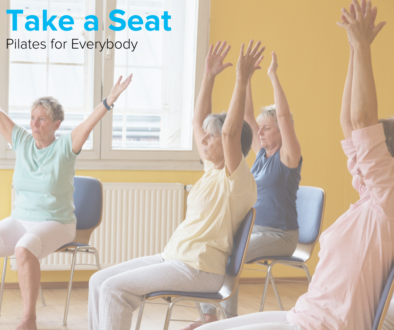Say the name “Chair Pilates” and it might immediately conjure up images of people working out on the Wunda or MVe® chairs, but teaching on a regular chair enhances accessibility for every body! In these trying times, some of us are still teaching a lot virtually and chair gives us a new option to meet our students needs, or we may find ourselves working at Nursing Homes, Y’s, and other large facilities where we have less fit individuals in large classes and have little or no Pilates equipment. Chair Pilates helps instructors reach a market that is often underserved: the housebound, the sedentary, the students with orthopedic or health issues that cannot get up and down from the floor, the frail, and the obese.
Most of the benefits of Pilates can be gained in a chair class format by adapting exercises from mat and the equipment to a chair. Specifically, students who participate in chair workouts regularly can expect to gain strength, flexibility, mobility, and to improve posture, coordination and balance. The more de-conditioned an individual is, the less aware they are of their body they are and a downward spiral may result in less and less movement and function. Working on a simple chair meets students where they are and helps them reclaim the joy of health while positively impacting their health.
Where to start? With the chair! You want to have students work on chairs that are sturdy and will not slip. The chair should provide room to sit on its edge, upright against its back, allow for a variety of positional changes such as legs straddled and side sitting, be sturdy enough to provide support when working out beside and behind it. Good prop additions include hand weights, bands, tubes, small balls, and of course, Power Circles if they are available. Props should always be positioned under the chair or well away from the chair so they don’t create a trip hazard.
A chair workout should begin with an opening that goes beyond screening the class members and provides them with a small bit of education on a Pilates Principle or Key Concept you want to focus on. Next move to the Centering portion, which should be extended and include fundamentals and mobilizations to warm the body up. The next segment is the Dynamic Workout portion and it will create the bulk of the class time. This is the more intense Pilates exercise portion.
When selecting Pilates exercises to include on the chair you want to work to create a 3 dimensional, balanced workout that includes spinal flexion, extension, lateral flexion and rotation in a variety of positions. Additionally, you want to build the 4 S’s – stability, strength, stretch, and stamina. Consider the goals of the exercise you are adapting and try to honor them. Sequence your workouts to minimize positional changes, and to avoid over-fatiguing any body part. Mix in functional movements that people often struggle with that will help them in life, such as reaching overhead, putting on a seat belt, getting out a chair etc.
Finally, use the Ending portion to provide a cool down. You want to include balance training as well as some functional focus on activities of daily living that may not have been hit during the previous class time. Reinforce the educational focus you began with by providing small homework assignments and/or ideas on how to transfer the skills to real life.
Tailor your chair workouts to your groups. For example, if you have a class for people with arthritis add more mobilizations, if you are working with individuals who have Osteoporosis, limit flexion, lateral flexion and rotation and add in more extension and weight bearing work. Encourage all students to challenge themselves while honoring their limits and to listen to their bodies. Teaching chair classes is a rewarding endeavor that brings the joy of helping individuals live fuller, more mobile lives!
To learn more join Peak Pilates Master Instructor, Courtney Weis, for the Every Body Pilates CEC on February 18th. Earn 2 Peak Pilates CECS and expand your Pilates reach.
USA/ Asia: https://peakpilates.com/every-body-pilates-virtual-workshop-february-18-2022/
Europe/ Middle East/ Africa: https://peaku.peakpilates.eu/peaku/every-body-pilates?instance=61c2e38102e5de48e01afec3
Sample chair sequence
Position: Sitting on the edge of the chair
Prop: Light hand weights
-
- Pelvic Clocks
- Seated Roll Back
- Alternating Knee Folds with oppositional arms
- Arm Reach & Pull, Circles, Triceps Rocks
- Knee Spreads
- Mermaid
- Seated Pulling Straps
- Spinal Twist
By Zoey Trap, MS



